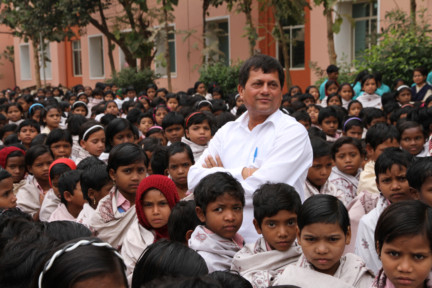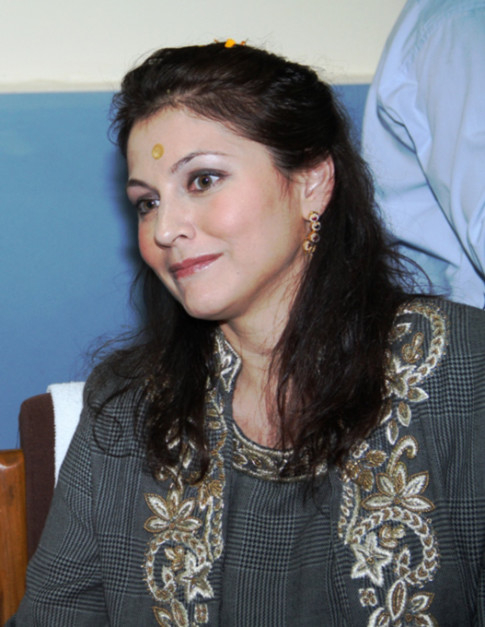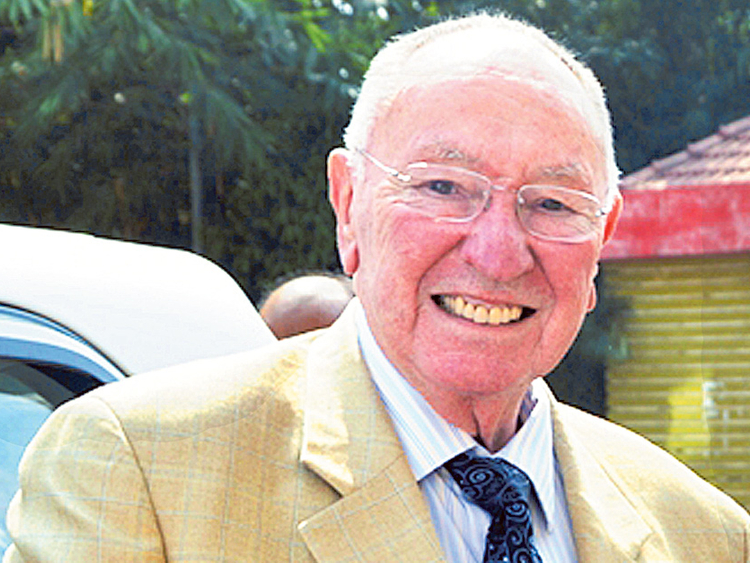
Schools big and small across India celebrate the birth anniversary of the country’s first prime minister, Jawaharlal Nehru, on November 14 as Children’s Day. Students stage plays, recite poems, sing and dig into food packets in school auditoriums to mark an occasion they look forward to each year.
But, obviously, no hall is big enough for 25,000 students!
I’m talking about Children’s Day celebrations at the world’s largest school for aboriginal boys and girls in Bhubaneswar, the capital of Odisha, which I had the good fortune to witness. Around 25,000 tribal students sat in rows after rows on neatly arranged plastic chairs in an open field under the blue sky watching a cultural show put on by their peers after weeks of rehearsal. It was a sea of children of all ages as far as the eyes could see — a spectacle which can easily move anyone to tears.
Kalinga Institute of Social Sciences in Odisha [formerly known as Kalinga] provides free education from KG [Kindergarten] to PG [Post Graduation], food, accommodation and health care to a record number of poor students. The fully free residential academy caters only to tribals, also called Adivasis accounting for one-fourth of Odisha’s population.
These indigenous people, comprising 64 tribes inhabiting the coastal state’s forests, are among India’s most neglected. Even more marginalised than Dalits, or untouchable low-caste Hindus, they are easy pickings for Maoists, also known as Naxalites, spearheading an increasingly violent rebellion against an exploitative State.
The man trying to eradicate poverty with education is charismatic 50 years old Achutya Samanta. Always clad in blue jeans and a white shirt, the crusader fighting for Odisha’s wretched for the past 22 years, never raises his voice. Outwardly, the human dynamo is a picture of calm — his twinkling eyes and beatific smile do all the talking even as he listens. A table and a few chairs under a leafy Kadamba tree serve as his office as birds chirp overhead and well-mannered, dark, stocky children mill about.
“Educating just one generation of tribal children can usher in a sea change”, he told Weekend Review. Interestingly, 55 per cent of Kalinga students are girls. The maverick has plans to educate two million more aboriginals in the next 10 years. He made his goal sound as simple as catching a film at a theatre or ordering a pizza. But given his 18-hour-workdays and phenomenal track record, he obviously has a game plan.
Back in 1992 — with apparently only Rs5000 (Dh290)in his pocket — Samanta kickstarted not only Kalinga with 125 illiterate and malnourished tribal children but also KIIT, or Kalinga Institute of Industrial Technology, with just two rooms and 12 students. KIIT quickly grew into one of India’s finest and most profitable private universities offering courses in Medicine, Engineering, Information Technology, Bio-Technology, Fashion, Management and Law in a separate campus near Kalinga.
Catering to wealthy aspirational India, fully residential and multidisciplinary KIIT is today home to nearly 25,000 students, including 500 from overseas. Spread over 25 square kilometres, it charges hefty fees just like other private educational hubs dotting metropolitan cities and state capitals across the country. But most importantly, KIIT foots the bill for Kalinga.
“It’s very simple. KIIT funds Kalinga,” said Samanta who calls his business model “cross-subsidisation” — a calibrated social service initiative which has won him kudos globally, including honorary doctorates from a dozen universities around the world.
The marvel that’s Kalinga is a magnet for VVIPs. Presidents, prime ministers, Nobel laureates, Supreme Court judges and ambassadors are among its frequent visitors; overwhelmed dignitaries have recorded in writing that dropping in is like a pilgrimage. Manmohan Singh, prime minister of India from 2004 to 2014, flew to the charitable enterprise in 2009 and 2012 underlining its charm. A.P.J. Abdul Kalam, India’s former president visited irresistible Kalinga thrice.
Kalinga students appear for school-leaving board examination before enrolling for BA, BSc or BCom degrees. It also has post-graduate courses in all major subjects of Arts, Science and Commerce streams living up to its catchy motto of providing education from KG to PG! The boarders obviously don’t live in the lap of luxury: an American visitor described living conditions as Dickensian. Dormitories have three-tier bunks, washrooms are basic and standards meals of rice and dal cooked with seasonal vegetables are eaten sitting cross-legged on the floor from stainless steel plates which students clean themselves.
But Kalinga amenities are a godsend considering that most children are from poverty-stricken families battling starvation and epidemics. Laptops are conspicuous in otherwise Spartan classrooms and hostels, though. Each classroom displays a framed set of 10 core life skills Kalinga seems determined to instil: self awareness, decision making, creative thinking, effective communication, dealing with emotions, empathy, problem solving, critical thinking, interpersonal relationship and coping with stress.
Kalinga students do remarkably well in school, college and university examinations; 95 per cent pass the school-leaving examination in the first division. But they are no bookworms as the academy stresses on extra-curricular activities, particularly archery — which tribals have a knack for — and rugby. The Kalinga junior rugby team has shone in tournaments in India and abroad. Significantly, 5 per cent of KIIT seats are reserved for Kalinga students who clear the tough KIIT entrance examination. Kalinga students who make the grade don’t have to pay a penny to study at one of the country’s most expensive universities.
I asked Samanta how exactly he manages to run the fully free Kalinga year after year without any financial assistance from the state or federal government.
Giving figures, Samanta said that Rs750-800 million is required to run Kalinga despite every attempt to cut costs. He cited belt-tightening measures such as keeping the staff down to 800 and deploying senior students in the dining hall to serve food and giving hair cuts to juniors and teaching students to stitch their own clothes. The children even produce their own pickles, soaps, detergents and phenyl.
“KIIT outright gives Kalinga Rs300 million. Moreover KIIT’s 10,000 staff donate three per cent of their salary to Kalinga, amounting to Rs200-250 million. Around 500 contractors doing business with KIIT donate five per cent of their profits to Kalinga, bringing in another Rs40 million. Kalinga also gets donations from over 200 wealthiest parents whose son or daughter is a KIIT student. And agencies such as Unicef foot the bill for some specific projects. That’s how Kalinga makes ends meet”, he said.
“You can say that I live for Kalinga. You will be amazed to know that KIIT today has outstanding bank loans of Rs5 billion, which will be repaid in seven-eight years as per plans because KIIT is a very stable organisation. But even this huge liability hasn’t stopped me from spending millions on Kalinga because it’s my top priority. Actually KIIT’s raison d’etre is Kalinga.”
Significantly, Samanta is no stranger to grinding poverty: he experienced it first-hand. His father worked for Tata Steel. But after his sudden death in 1970, his mother had to bring up seven children in Odisha’s Kalarabank village by doing menial jobs. “We couldn’t afford even one square meal in two days. My mother gathered edible weeds from the river-bed to feed us. I toiled in the fields from the age of six. We couldn’t afford to buy kerosene for even one lamp, compelling me to go to my teacher’s house with my books to study. We were saved after Tata Steel gave a job to one of my brother’s on compassionate grounds”, reminisced Samanta.
“Poverty was clearly god’s gift to me. He prepared me for my life’s mission by subjecting me to hardships from a tender age”, he said. A bright student, he did his MSc in chemistry and was employed as a lecturer for 10 years before he gave up his job to set up Kalinga and KIIT. A confirmed bachelor living in a small, rented flat, he explained: “If I had a wife or children, I would have had to look after them instead of the tribal poor. So I decided against marrying.”
My companions at Kalinga’s Children’s Day celebrations were Martin Hunter and Marike Paulsson. Hunter, a British professor of law, and Paulsson, an international arbitration expert from Miami university, were speakers at a symposium organised by KIIT Law School.
Hunter, who has visited Kalinga several times, told me: “When I first saw the kids in 2008, I was reminded of children in Africa whose pictures we saw in newspapers. And after looking into their eyes and holding their hands I told Samanta that I wanted to help him in whatever way he wanted.”
“It was such a life-changing experience that on my journey back to London, I made a commitment never to walk away from those children. I have made a provision in my will leaving a substantial portion of my estate for the tribal school. Some of the children I met in 2008 are now in the Law School. Subconsciously, I keep coming just to see them growing up into fine lawyers.”
Paulsson, on her maiden visit, said that she was “stirred to her core”. “Children don’t ask to be born. We bring them into this world. And as a mother of a three-year-old, I think every child is entitled to happiness. But these tribal children from the bottom of society had no chance on earth to be happy. Amazingly, one man has done something that was next to impossible — he has filled their lives with happiness. It’s an incredible achievement. May his tribe increase!”
S. N. M. Abdi, noted Indian journalist and commentator, writes across Gulf News.














